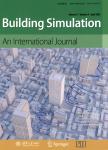Assessing cooling energy reduction potentials by retrofitting traditional cavity walls into passively ventilated cavity walls
由翻新传统的洞墙进消极地通气的洞墙估计冷却精力减小潜力作者机构:Department of Civil and Environmental EngineeringUniversity of DelawareNewarkDE19716USA The Durham School of Architecture Engineering and ConstructionUniversity of Nebraska LincolnLincolnNE68588USA
出 版 物:《Building Simulation》 (建筑模拟(英文))
年 卷 期:2021年第14卷第4期
页 面:1295-1309页
核心收录:
学科分类:08[工学] 081404[工学-供热、供燃气、通风及空调工程] 0814[工学-土木工程]
主 题:low-cost energy retrofit building envelope cavity wall stack effect space cooling energy reduction CFD
摘 要:A major roadblock in achieving substantial building energy reduction is the low performance of old buildings that account for a significant portion of the building energy *** low-cost energy retrofit solutions that do not disrupt occupants’daily life during the retrofitting is the key to successful building energy retrofit *** this paper,a novel and low-cost exterior wall retrofitting solution is introduced,and its performance in reducing space cooling load was quantitatively evaluated to demonstrate its feasibility and *** primary goal of this paper is to provide a quantitative assessment of the cooling-energy savings potential by using the proposed new wall *** intended retrofitting targets are the large amount of existing cavity-wall buildings located in hot climate *** quantification of the before-after heat-flux reduction was conducted through a 3-dimensional steady-state low turbulence computational fluid dynamics(CFD)model,which is validated by benchmarking its prediction against the published experimental case *** outcomes of the investigation suggest that this simple low-cost solution has great potentials in reducing buildings’summer cooling load in hot climate *** applicability of this solution is not limited to retrofitting existing *** energy-efficient building designs can also adopt this solution in their envelope systems.



